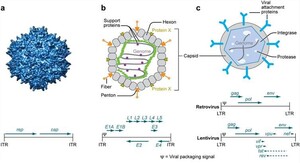Development of Gene Therapy Viral Vectors for Rare Diseases
Cuerpo
In many cases, gene therapy requires a vector to deliver the gene therapy drug to the target cell. Viral vectors have been one of the most widely studied vectors due to their outstanding transduction efficiency and other significant advantages. Viral vector-based gene therapy has now achieved good clinical results. More than a dozen viral gene therapy products have been approved for the treatment of cancer, infectious diseases, and rare single-gene disorders. The main types of viral vectors used clinically for in vivo gene therapy include adenovirus, adeno-associated virus (AAV), herpes simplex virus (HSV), retroviruses, and lentiviruses.
In recent years, scientific advances in viral vector engineering, rare disease genome identification, and gene editing are ushering in a new era of viral gene therapy. Rare disease research institutions are committed to using cutting-edge technologies in molecular biology and cell biology to provide comprehensive viral vector development solutions, including the design and construction of suitable viral vectors as well as the production and purification of viral vectors.
Gene Therapy Viral Vector Development for Rare Diseases
Development of Adenoviral Vectors
Develop adenoviral vectors that produce milder immune responses to deliver larger DNA packages with less risk, accelerating the development of effective gene therapies for rare diseases.
Development of Adeno-Associated Virus Vectors
Aim to better understand AAV vector gene delivery and activation of gene expression to help improve vector manufacturing and efficiency of AAV gene therapy and develop AAV vectors for gene therapy of rare diseases.
Development of Retroviral Vectors
Retroviral vector development includes the design of safer vectors, the establishment of transduction protocols, and the evaluation of the efficacy, and safety of gene therapy vectors.
Development of Lentiviral Vectors
A variety of strategies are used to improve the expression and transduction efficiency of lentivirus vectors and achieve tissue or cell type specificity to help researchers design and develop efficient and safe lentivirus vectors.
Development of Herpes Simplex Virus Vectors
Develop HSV vectors for gene therapy of rare diseases, particularly neurological disorders, to efficiently deliver genes into the central and peripheral nervous systems.
Development of Vaccinia Viral Vectors
Develop highly attenuated, non-replicating, or poorly replicating vaccinia virus vectors for rare disease gene therapies.
Development of Baculovirus Vectors
Safe and effective baculovirus vectors for gene delivery can help accelerate the development of gene therapies for a number of rare diseases such as Duchenne muscular dystrophy (DMD).
Development of Alphavirus Vectors
Develop alphavirus vectors with reduced cytotoxicity and enhanced gene expression capacity to enable effective gene delivery in gene therapies for rare diseases.
In addition to the more common vector systems, rare disease research companies are also developing other viral vectors for targeted gene therapy, including measles virus vectors, foamy virus vectors, flavivirus vectors, Newcastle disease virus (NDV), picornaviruses, etc.
Reference
- Schaffer, D. V.; et al. Molecular engineering of viral gene delivery vehicles. Rev. Biomed. Eng., 2008, 10: 169-194.












Comentarios